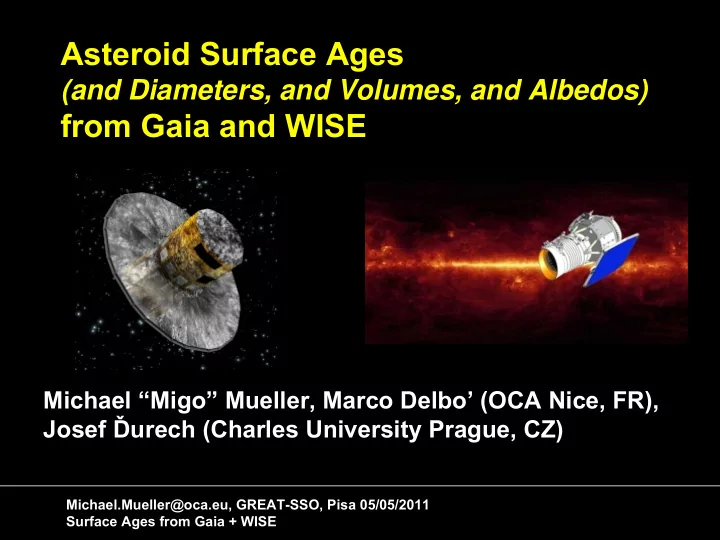

Asteroid Surface Ages (and Diameters, and Volumes, and Albedos) from Gaia and WISE Michael “Migo” Mueller, Marco Delbo’ (OCA Nice, FR), Josef Ď urech (Charles University Prague, CZ) Michael.Mueller@oca.eu, GREAT-SSO, Pisa 05/05/2011 Surface Ages from Gaia + WISE
Overview Gaia: 10,000—100,000’s shapes and spin axes of asteroids Allows better understanding of thermal data • Better constraints on D and p V • Itokawa, Lutetia, and friends • Mass densities to within 30—40% or so • Thermal inertia • What is thermal inertia and why should I care? Yarkovsky/YORP, regolith, surface age • Data situation IRAS, Spitzer, WISE, … • Modeling situation Precursor study: IRAS + DAMIT Outlook: WISE + Gaia Michael.Mueller@oca.eu, GREAT-SSO, Pisa 05/05/2011 Surface Ages from Gaia + WISE
Thermal Emission of Asteroids F( λ ) = D 2 ∫ Planck ( λ , T(A)) dA Peaks between < 10 µm (NEAs) and ~100 µm (TNOs) • Observationally difficult but doable • Need adequate thermal model • Good handle on size and albedo • (the latter with optical photometry = measure of D 2 *p V ) • … and on any • thermal property Michael.Mueller@oca.eu, GREAT-SSO, Pisa 05/05/2011 Surface Ages from Gaia + WISE
Thermal Inertia Г Resistance to change in surface temperature Г = √ ( ρ c κ ) • Triggers Yarkovsky effect • Important for mission planning • Regolith properties / surface age from Г Michael.Mueller@oca.eu, GREAT-SSO, Pisa 05/05/2011 Surface Ages from Gaia + WISE
What Do We Currently Know About Г ? Regolith even on small NEAs. How does it form? • How does it stick? Hints at correlation with D (Delbo’ et al., 2007) Important for • Yarkovsky and YORP Mission planning • Any dependence on taxonomy? On orbit? Family? Anything? We need more data! Michael.Mueller@oca.eu, GREAT-SSO, Pisa 05/05/2011 Surface Ages from Gaia + WISE
Thermophysical Model (TPM) Takes direct account of Shape and spin state • Thermal conduction leading to thermal inertia • Surface roughness • References: e.g., Spencer (1990), Lagerros (1998), Mueller (2007) Michael.Mueller@oca.eu, GREAT-SSO, Pisa 05/05/2011 Surface Ages from Gaia + WISE
Two Modeling Approaches Thermophysical modeling (TPM) Detailed model of shape, spin, thermal conduction, roughness • Need: high-quality multi-wavelength thermal data from • multiple nights / epochs; model of shape + spin state Thermal inertia • For now: only doable for ~single objects at a time • Simple models (STM, NEATM) Simplistic assumptions on shape, temperature • x Less unknowns, less data required • Sub-solar point ∆ D ~ 15—20%, ∆ p V ~ 30—40% • from modest-quality single-night data Most prolific source of asteroid D and p V • Great for statistical studies / coarse studies of single objects • Michael.Mueller@oca.eu, GREAT-SSO, Pisa 05/05/2011 Surface Ages from Gaia + WISE
TPM Diameters: “Ground Truth” (25143) Itokawa: Hayabusa rendezvous target D from Th. Müller et al. (2005): 0.32 ± 0.03 km • D from Demura et al. (2006): 0.327 ± 0.006 km • (21) Lutetia: Rosetta flyby target D from M. Mueller et al. (2006): • 98.3 ± 5.9 km D from Rosetta flyby: ~ 98 km • We estimate TPM diameters to be within 10%, that’s probably conservative (more work needed). Mass densities from AO + TPM can be good within 30—40 % – if shape + spin axis are known, if good thermal data are available, and if thermal modeling is done properly (e.g., Mueller et al., 2010). Michael.Mueller@oca.eu, GREAT-SSO, Pisa 05/05/2011 Surface Ages from Gaia + WISE
Thermal Data Situation Ground-based observations: Extremely challenging due to high background • Only practical for select targets • Current largest data set from IRAS All-sky survey in 1983 (!) at 12, 25, 60, 100 µm • Coarse D and p V of 2,288 (bright) asteroids • Latest analysis: Ryan & Woodward (2010) • WISE data have just been taken (2010—2011) All-sky survey at 3.6, 4.5, 12, and 25 µm • 100,000’s of asteroids • Waiting for first useful calibrated data release… • Nominal data analysis based on assumed spherical shape • With Gaia shapes, we can do better! • Michael.Mueller@oca.eu, GREAT-SSO, Pisa 05/05/2011 Surface Ages from Gaia + WISE
Precursor Study: IRAS + DAMIT Can we really run the TPM in batch mode? Fully automatically, w/o crashes? Within reasonable CPU time? Do results make any sense? Precursor study: IRAS fluxes + DAMIT shapes and spin state Download IR fluxes, shapes, and spin states automatically • 94 objects as of 28 Oct. 2010 • Retrieve ephemeris, correct for lighttime + filter breadth • Run TPM • Gather results, estimate error bars • Result: IDL batches run smoothly w/o crash nor human interference • TPM runs done within ~30 days • D, p V , and Г results of previous studies are reproduced • (Mueller et al., 2006; Delbo’ & Tanga, 2009 for the most part…) Michael.Mueller@oca.eu, GREAT-SSO, Pisa 05/05/2011 Surface Ages from Gaia + WISE
What Does This Mean for Gaia + WISE Data Set? TPM analysis can be done in ~300 days Using my current computer (…) but after tweaking TPM code • for speed (factor 10+ speed-up possible) Will provide best catalog of asteroid D, p V , and Г (10,000+ objects) Synergy between Gaia and WISE, and maybe ExploreNEOs • Increase # of measured Г by 3 orders of magnitude!!! Allows first systematic studies of • Regolith vs taxonomy • Regolith vs orbit (nner vs outer belt, …) • Long-term goal: correlate Г with surface age, constrain dynamical + collisional history of asteroid main belt Observational handle: Г of collisional families of known age • Auxiliary work: lab studies of thermal inertia of regolith • particles; theoretical modeling of regolith formation / aging Michael.Mueller@oca.eu, GREAT-SSO, Pisa 05/05/2011 Surface Ages from Gaia + WISE
Recommend
More recommend